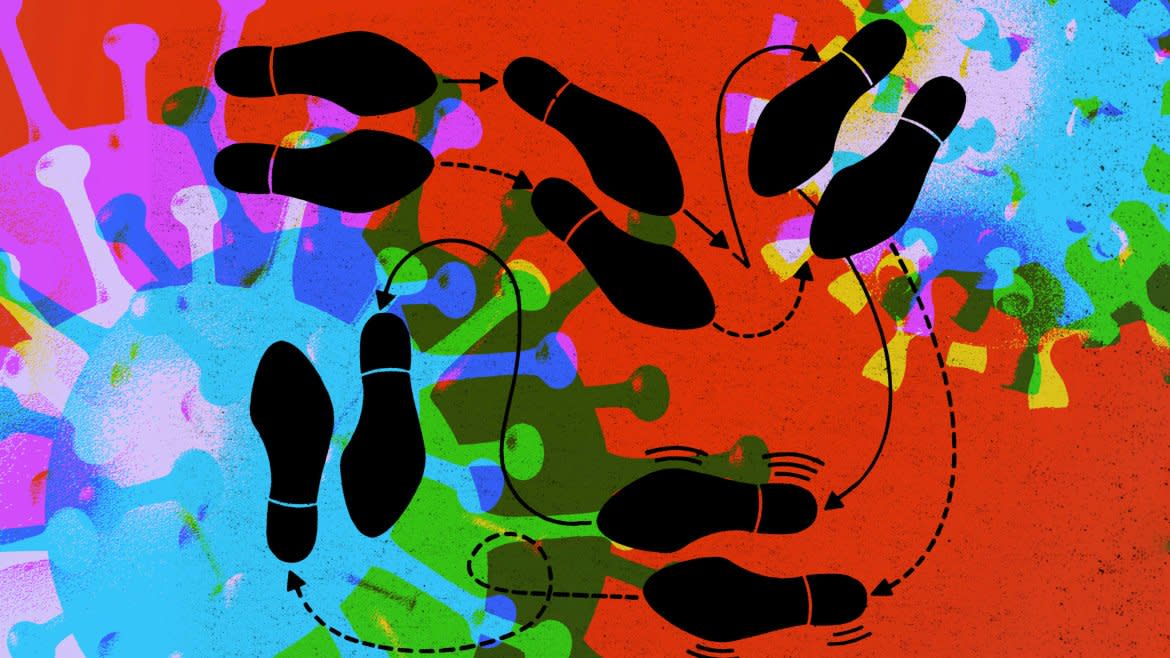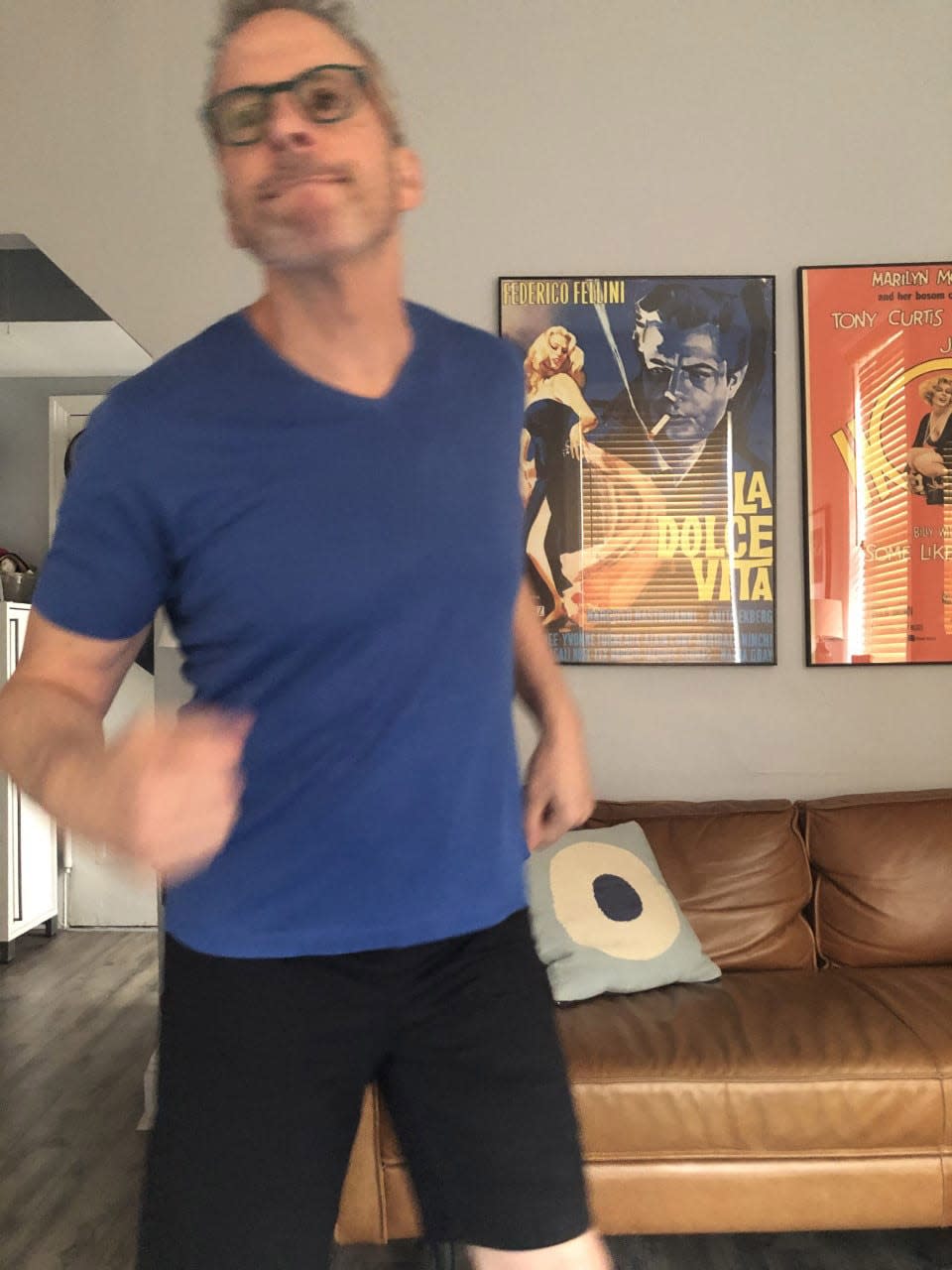How Dancing—In the Moonlight—Has Helped Keep Me Sane During Lockdown

Even before the pandemic, with the exception of a pair of weekly classes I taught at NYU, I spent most days working in my apartment. I’m a writer; I don’t like doing it at a Starbucks or in a Writer’s Room. I prefer being at home where I at least have some autonomy on the distractions.
My place isn’t large—a compact one-bedroom—but I didn’t feel claustrophobic because I was spending most nights out meeting friends for dinner, squeezing in a workout at the gym, and going to the theater. A lot.
Now mostly unable—and for a while cautiously unwilling—to spend evenings out to balance my days in, I needed to find ways to make my life work ‘round the clock in less than 500 square feet. I had Zoom happy hours, Zoom game nights, Zoom workouts, Zoom yoga (both clothed and nude), and even a couple of Zoom dates (I’m currently single). I binge-watched series, devoured movies on the Criterion Channel and TCM, and joined a gay book group a friend started.
Prepare for Sex and Dating to Get Even More Complicated Once the Lockdown Lifts
And though, like lots of us, I contended with bouts of fear and hopelessness, I found a groove in which I was pretty content, reasonably productive, and only a little lonely—while awake. Sleep was another story. I’d easily fall asleep, but began consistently waking in the middle of the night, my body gripped by the very real, but not unexpected anxieties both small (Had I unconsciously touched my face while shopping at Trader Joe’s?) and large (Will we all die before there’s a vaccine or will climate change kill us first?).
I was doing all the right things; I was engaged intellectually and socially, eating pretty well, exercising regularly. I’d even begun meditating again. If those things weren’t working, what the hell would?
Then one day from my window I heard a car stereo blaring “Dancing in the Moonlight,” an upbeat radio hit from my childhood. “Everybody’s dancing in the moonlight/everybody’s feeling warm and bright.”
I immediately flashed on hearing it on a tinny transistor radio hanging from an umbrella on Jones Beach and seeing two teen girls swaying to it on a blanket not far where I sat with my family. As soon as the car drove away I went to Apple Music and found it. “You can’t dance and stay uptight.” I played it a few times before its blunt message got into my head.
Dance, Fool, Dance.
So, I did, and that night I felt tired yet exhilarated when I went to bed and slept the whole night through. And now, for these past few months, I dance around my apartment at least four nights a week. And I love it.
I choose a playlist—changing it up most nights, usually by plugging in a few words describing what I’m in the mood for into Spotify or Apple Music, plug my sound canceling Air Pods into my ears, and then flail about for at least an hour. I don’t fuss much over the song selection; I let the streaming service du jour pick the next tune. Most of the time I really like not knowing what’s going to be played next.
Releasing control is key to its pleasure. And it reminds me of what it was like when I danced in clubs. The DJ chose what was coming next. If I liked it, I kept dancing; if I didn’t, I’d grab a drink or take a pee. Same thing in my 12x12 living room, though admittedly there are those times I just click on the next song.
Doing it at night is essential. I think it’s more than just the proximity to my bedtime. I’ve always liked dancing best at night—and with the lights off. When I was a kid danced in my room to Donna Summer during the day because that was the only time I was alone in my house. But even then I enjoyed it most in winter when the sun was down by 430 I felt freer to move my body to only the dim light of an outside streetlamp and the low green glow of the stereo display panel.
I don’t know why I cared so much. I was a pretty good dancer. I always had been. I’m not sure why. I knew I longed to be as cool as the black dancers on Soul Train, who moved like their legs were on rubber bands; and I didn’t want to look any dorkier than I already was at the Bar and Bat Mitzvahs I had started being invited to. And especially not a few years later when I began attending Sweet 16s and a couple of high school dances—not that it mattered as by that time white boys my age were too self-conscious to do more than air-guitar to most songs, which disappointed me.
I wanted to dance, but my family moved places a lot—one year I was in three different schools—so wasn’t secure enough yet to risk a social faux pas.
Luckily my oldest sister, Michelle, had just started community college and, having no idea what to do with her life (she eventually became a nurse), decided to minor in dance. She would come home, and I was pretty much the only one in the family who was willing to watch her show off a routine she’d learned in class.
A few times she’d try me to do them with her, but I disliked the tink-tink sound of dance class pianos, so agreed only if we could practice to an actual record. (This is the 1970s, so this means actual vinyl record). I didn’t really take to it, but I really enjoyed when she’d just give up and we’d freestyle around the basement to what we’d put on. In my memory it was usually something from the Saturday Night Fever soundtrack.
We had so much fun that soon my sister would get me to dress up to look older, then we would drive off in her beat-up orange Volkswagen Beetle (the car I learned to drive on before I even had a learner’s permit) and sneak my way into the nearest disco. We were living in Long Beach, NY, by this time and luckily the nearest club one town over, Speaks, was one of the best around.
I was only 14 the first time went. The drinking age back then was 18, and it surely would’ve lost their license had I been discovered. I’ve never been much of a drinker; maybe I’d take a few sips of my sister’s tequila sunrise, and we were there to dance, which we did, sometimes for hours. On a school night.
I moved to NYC to go to film school at NYU. I was totally devoted to my work. If I wasn’t making a film, I was reciprocally crewing on someone else’s. In my spare time I wrote and directed a few plays, and even tried my hand at radio (I was bad).
I went to CBGB’s a few times to see punk bands like Richard Hell and the Voidoids, or to the TKTS booth at Times Square to see any show I could afford, so I didn’t dance much until after graduation when Area was the hottest club in town, but I had the most fun on gay nights at Palladium (before it became an NYU dorm).
A few years later, my mother and husband #3 moved to a mountain in the west of Ireland. It was green and beautiful, and very peaceful and 4 miles away from the small town below. Luckily, one of the three houses in the vicinity had folks near my age. Soon I fell in love with one, and we spent nearly every night—along with a few other friends I’d made, some of whom I am still friends with today—dancing at the one club in town, Spirals.
After four hours of dancing to songs like “Fisherman’s Blues” by Irish band The Waterboys and the ubiquitous “Come on Eileen” from yet another one-hit wonder, Dexy’s Midnight Runners, we’d emerge at 1 a.m., saunter over to the burger joint—or chipper, as they called it—for a bag of greasy fries, and then walk home up the dark two-lane country road to our homes. Sometimes we’d walk past our homes to make out on top of the mountain until the sun came up.

Michael Zam lets loose in his living room.
That first night I decided to dance in my apartment I wanted to begin, of course, with “Dancing in the Moonlight,” so I chose a playlist called one-hit wonders, and there it was. This song eventually segued to “Come on Eileen.”
If I had any worries my body couldn’t move the way it had when I was 20, weeks of dancing to it at Spirals over three decades ago had embedded enough muscle memory inside of me to push me to start moving now as if I was almost 20 again. And it felt amazing.
Why hadn’t I done this for so many years? The last time I went dancing that I could recall was at gay circuit party, Allegria, with one of my best friends, James. We’d stop eating carbs six weeks previously and work out incessantly, so we felt proud enough of our bodies to join the 2,000 other shirtless for a long night of dancing, though it was never really dancing. We generally just moved up and down in a huddle and groped and grinded against each other until the Ecstasy wore off. I’m such a lightweight half a tablet did me for the entire day.
Otherwise, I only danced here and there over the next few decades, at the occasional wedding—though most of my friends had finally aged out of those—and on the cruises my late partner, Bob (Smith), a stand-up comedian, performed on. But that became increasingly rare as most things stopped when his body gradually deteriorated from ALS.
Not long after “Come on Eileen” finished playing in my apartment, I was about to pack it in for the night. I remember thinking: What could possibly top the exhilaration I was feeling after leaping about in the present to a song I had so loved leaping about to so much from my past?
And then a song popped on that I hadn’t heard in years and which would send the dance floor in a frenzy when the DJ spun it at Palladium, “(You Spin Me Round) Like a Record.” Bob loved to dance to this song, too.
I remembered the name of the band: Dead or Alive. And I remembered reading that the lead singer, Pete Burns, is dead. And then with an odd laugh, I thought Bob is dead, too. And then I thought, “But I’m still alive.” And I hadn’t really felt this alive for a very long time—not since this fucking pandemic started. So, I’m going to dance.
And that’s just what I’ve been doing most nights since.
Get our top stories in your inbox every day. Sign up now!
Daily Beast Membership: Beast Inside goes deeper on the stories that matter to you. Learn more.

